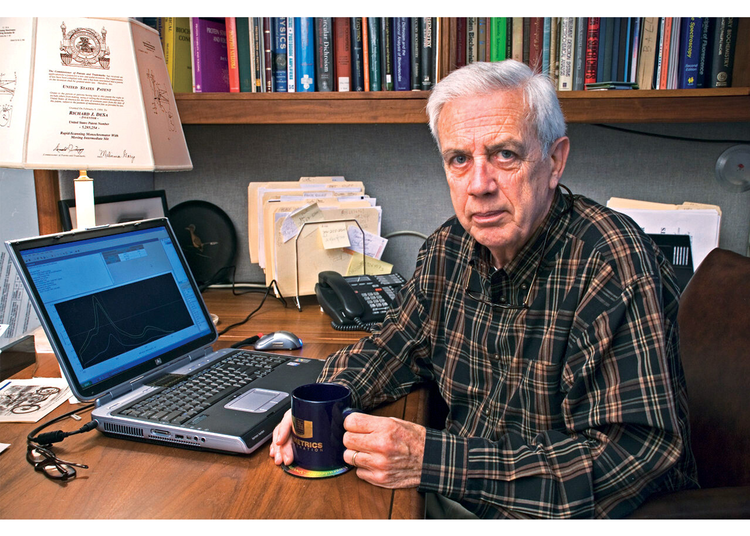The Basic Principles Of Uv/vis
The Basic Principles Of Uv/vis
Blog Article
5 Easy Facts About Circularly Polarized Luminescence Shown
Table of ContentsThe Only Guide to Circularly Polarized LuminescenceGetting The Uv/vis To WorkUnknown Facts About Uv/vis/nirSee This Report about Uv/vis/nirSpectrophotometers for Beginners

Although spectrophotometry is most typically applied to ultraviolet, visible, and infrared radiation, modern spectrophotometers can interrogate broad swaths of the electromagnetic spectrum, including x-ray, ultraviolet, visible, infrared, and/or microwave wavelengths. Spectrophotometry is a tool that depends upon the quantitative analysis of molecules depending upon just how much light is taken in by colored substances.
7 Easy Facts About Circularly Polarized Luminescence Explained
A spectrophotometer is frequently utilized for the measurement of transmittance or reflectance of services, transparent or nontransparent solids, such as polished glass, or gases. Although lots of biochemicals are colored, as in, they soak up noticeable light and for that reason can be determined by colorimetric treatments, even colorless biochemicals can frequently be transformed to colored compounds ideal for chromogenic color-forming reactions to yield substances suitable for colorimetric analysis.: 65 However, they can also be designed to determine the diffusivity on any of the listed light varieties that typically cover around 2002500 nm utilizing different controls and calibrations.
An example of an experiment in which spectrophotometry is used is the determination of the equilibrium constant of an option. A certain chemical reaction within an option might take place in a forward and reverse instructions, where reactants form items and items break down into reactants. At some time, this chemical response will reach a point of balance called a stability point.
What Does Uv/vis Mean?
The quantity of light that travels through the service is a sign of the concentration of specific chemicals that do not allow light to pass through. The absorption of light is because of the interaction of light with the electronic and vibrational modes of particles. Each kind of particle has a specific set of energy levels connected with the makeup of its chemical bonds and nuclei and hence will absorb light of particular wavelengths, or energies, leading to special spectral residential or commercial properties.
They are extensively utilized in lots of industries consisting of semiconductors, laser and optical manufacturing, printing and forensic assessment, as well as in labs for the research study of chemical her latest blog substances. Spectrophotometry is frequently utilized in measurements of enzyme activities, decisions of protein concentrations, decisions of enzymatic kinetic constants, and measurements of ligand binding reactions.: 65 Eventually, a spectrophotometer is able to determine, depending on the control or calibration, what substances are present in a target and exactly how much through computations of observed wavelengths.
This would come as a solution to the previously developed spectrophotometers which were not able to absorb the ultraviolet correctly.
The Only Guide for Spectrophotometers
It would be discovered that this did not provide acceptable outcomes, therefore in Model B, there was a shift from a glass to a quartz prism which allowed for much better absorbance outcomes - circular dichroism (https://www.abnewswire.com/companyname/olisclarity.com_129679.html#detail-tab). From there, Model C was born with a modification to the wavelength resolution which wound up having 3 systems of it produced
It irradiates the sample with polychromatic light which the sample absorbs depending upon its homes. It is transmitted back by grating the photodiode variety which finds the wavelength region of the spectrum. Because then, the production and execution of spectrophotometry devices has actually increased profoundly and has become one of the most ingenious instruments of our time.

Top Guidelines Of Circular Dichroism
The grating can either be movable or repaired.
In such systems, the grating is fixed and the intensity of each wavelength of light is measured by a different detector in the array. Furthermore, most modern mid-infrared spectrophotometers use a Fourier transform strategy to get the spectral information - https://visual.ly/users/julieanndesalorenz30606/portfolio. This technique is called Fourier change infrared spectroscopy. When making transmission measurements, the spectrophotometer quantitatively compares the fraction of light that goes through a recommendation service and a test solution, then digitally compares the strengths of the two signals and computes the percentage of transmission of the sample compared to the reference requirement.

Report this page